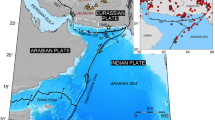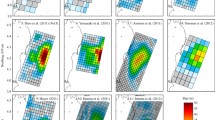Abstract
Following the 2007, August 15th, M w 8.0, Pisco earthquake in central Peru, Sladen et al. (J Geophys Res 115: B02405, 2010) have derived several slip models of this event. They inverted teleseismic data together with geodetic (InSAR) measurements to look for the co-seismic slip distribution on the fault plane, considering those data sets separately or jointly. But how close to the real slip distribution are those inverted slip models? To answer this crucial question, the authors generated some tsunami records based on their slip models and compared them to DART buoys, tsunami records, and available runup data. Such an approach requires a robust and accurate tsunami model (non-linear, dispersive, accurate bathymetry and topography, etc.) otherwise the differences between the data and the model may be attributed to the slip models themselves, though they arise from an incomplete tsunami simulation. The accuracy of a numerical tsunami simulation strongly depends, among others, on two important constraints: (i) A fine computational grid (and thus the bathymetry and topography data sets used) which is not always available, unfortunately, and (ii) a realistic tsunami propagation model including dispersion. Here, we extend Sladen’s work using newly available data, namely a tide gauge record at Callao (Lima harbor) and the Chilean DART buoy record, while considering a complete set of runup data along with a more realistic tsunami numerical that accounts for dispersion, and also considering a fine-resolution computational grid, which is essential. Through these accurate numerical simulations we infer that the InSAR-based model is in better agreement with the tsunami data, studying the case of the Pisco earthquake indicating that geodetic data seems essential to recover the final co-seismic slip distribution on the rupture plane. Slip models based on teleseismic data are unable to describe the observed tsunami, suggesting that a significant amount of co-seismic slip may have been aseismic. Finally, we compute the runup distribution along the central part of the Peruvian coast to better understand the wave amplification/attenuation processes of the tsunami generated by the Pisco earthquake.








Similar content being viewed by others
References
Barrientos, S. E. (2007) Informe sobre las alturas de “run-up” alcanzadas por el tsunami asociado al sismo M w = 8.0 del 15 de Agosto de 2007 en la zona de Pisco. Peru, www.ceresis.org.
Beck, S., and Nishenko, S. (1990) Variations in the mode of great earthquake rupture along the central Peru subduction zone. Geophys. Res. Lett., 17, 1969–1972.
Beck, S., and Ruff, L. (1989) Great earthquake and subduction along the Peru trench. Physics of The Earth and Planetary Interiors, 57(3–4), 199–224.
Biggs, J., Robinson, D. P., and Dixon, T. H. (2009) The 2007 Pisco, Peru, earthquake (M8.0): Seismology and geodesy. Geophys. J. Int., 176(3), 657–669, doi:10.1111/j.1365-246X.2008.03990.x.
DeMets, G., Gordon, R. G., Argus, D. F., and Stein, S. (1990) Current plate motions. Geophys. J. Int., 101(2), 425–478.
DHN (2007) Informe post tsunami, http://www.dhn.mil.pe/docs/tsunami/Informe\_Post\_Tsunami\_Pisco\%202007.pdf.
Dorbath, L., Cisternas, A., and Dorbath, C. (1990) Assessment of the size of large and great historical earthquakes in Peru. Bull. Seism. Soc. Am., 80, 551–576.
Grilli, S. T., Ioualalen, M., Asavanant, J., Shi, F., Kirby, J. T., and Watts, P. (2007) Source Constraints and Model Simulation of the December 26, 2004, Indian Ocean Tsunami. J. Waterway, Port, Coastal and Ocean Eng., ASCE. doi:10.1061/(ASCE)0733-950X(2007)133:6(414).
Gutscher, M. A., Malavieille, J., Lallemand, S., and Collot, J.-Y. (1999) Tectonic segmentation of the North Andean margin: impact of the Carnegie Ridge collision. Earth and Planetary Science Letter, 168, 255–270.
Ioualalen, M., Asavanant, J., Kaewbanjak, N., Grilli, S T., Kirby, J. T., and Watts, P. (2007) Modeling the 26 December 2004 Indian Ocean tsunami: Case study of impact in Thailand. J. Geophys. Res., 112, C07024. doi:10.1029/2006JC003850.
Kelleher, J. (1972) Rupture zones of large South American earthquakes and some predictions. J. Geophys. Res., 77, 2087–2103.
Kendrick, E., Bevis, M., Smalley, R. J., and Brooks, B. (2001) An integrated crustal velocity field for the central Andes. Geochemistry, Geophysics, Geosystems, 2, doi:10.1029/2001GC000208.
Ocola, L. (2007) Aspectos fÌsicos del maremoto de Pisco del 15 de agosto 2007 y las inundaciones máximas. In terremoto de Pisco (Peru) del 15 de Agosto de 2007 (8.0 Mw), edited by H. Tavera, Direccion de Sismologia en CNDG/Instituto Geofisico del Peru, 395–420.
Okada, S. (1992) Internal deformation due to shear and tensile faults in a halfspace. Bull. Seismol. Soc. Am., 82, 1018–1040.
Perfettini, H., Avouac, J.-P., Tavera, H., Kositsky, A., Nocquet, J.-M., Bondoux, F., Chlieh, M., Sladen, A., Audin, L., Farber, D. L., and Soler, P. (2010) Seismic and aseismic slip on the Central Peru megathrust. Nature, 465(7294), 78–81.
Pophet, N., Kaewbanjak, N., Asavanant, J., and Ioualalen, M. (2010) High Grid Resolution and Parallelized Tsunami Simulation with Fully Nonlinear Boussinesq Equations. Computers and Fluids, doi:10.1016/j.compfluid.2010.09.030.
Sladen, A., Tavera, H., Simons, M., Avouac, J.-P., Konca, A.O., Perfettini, H., Audin, L., Fielding, E. J., Ortega, F., and Cavagnoud, R. (2010) Source model of the 2007 Mw8.0 Pisco, Peru earthquake: Implications for seismogenic behavior of subduction megathrusts. J. Geophys. Res., 115, B02405, doi:10.1029/2009JB006429.
Swenson, J., and Beck, S. (1996) Historical 1942 Ecuador and 1942 Peru subduction Earthquakes, and Earthquakes cycles along Colombia-Ecuador and Peru Subduction Segments. Pure and Applied Geophys., 146, 67–101.
Swenson, J., and Beck, S. (1999) Source characteristics of the November 12 1996 Mw = 7.7 Peru subduction zone earthquake. Pure and Applied Geophys., 146, 67–101.
Tavera, H., and Bernal, I. (2008) The Pisco (Peru) earthquake of 15 August 2007. Seismol. Res. Lett., 79(4), 510–515, doi:10.1785/gssrl.79.4.510.
Wei, G., Kirby, J. T., Grilli, S. T., and Subramanya, R. (1995) A fully nonlinear Boussinesq model for free surface waves. Part 1: Highly nonlinear unsteady waves. J. Fluid Mech., 294, 71–92.
Woodman, R. (2007) Observaciones del tsunami asociado con el terremoto de Pisco del 15 de Agosto 2007, In El terremoto de Pisco (Peru) del 15 de Agosto de 2007 (8.0 Mw)}, edited by H. Tavera, Direccion de Sismologia en CNDG/Instituto Geofisico del Peru, 351–362.
Acknowledgments
The authors are grateful to A. Sladen for providing the earthquake slip models used in this study and J.-P. Avouac, G. Hérail, M. Chlieh, B. Guillier and J.-X. Dessa for useful discussions. We wish to acknowledge two anonymous reviewers who, through their suggestions, have contributed to a substantial improvement of the first draft manuscript.
Author information
Authors and Affiliations
Corresponding author
Rights and permissions
About this article
Cite this article
Ioualalen, M., Perfettini, H., Condo, S.Y. et al. Tsunami Modeling to Validate Slip Models of the 2007 M w 8.0 Pisco Earthquake, Central Peru. Pure Appl. Geophys. 170, 433–451 (2013). https://doi.org/10.1007/s00024-012-0608-z
Received:
Revised:
Accepted:
Published:
Issue Date:
DOI: https://doi.org/10.1007/s00024-012-0608-z




